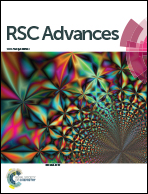Lanthanide complexes based on a conjugated pyridine carboxylate ligand: structures, luminescence and magnetic properties†
Abstract
Three lanthanide compounds have been synthesized, namely, {[Dy2(bpda)3(H2O)3]4·2H2O}(Dy-1), {[Sm(bpda)2·(H2O)]·H2O}n (Sm-2) and {[Tb2(bpda)3(H2O)3]4·2H2O} (Tb-3) (H2bpda = 2,2′-bipyridine-6,6′-dicarboxylic acid). Their structures were determined by single crystal X-ray diffraction and characterized by elemental analysis, infrared spectroscopy and thermogravimetric analysis. Dy-1 and Tb-3 are isostructural with a conjugate bimolecular four-nuclear cluster structure constructed with intramolecular hydrogen bonds and they form a 3D supramolecular structure with intermolecular hydrogen bonding. Sm-2 is a one-dimensional chain structure and is further connected by intricate hydrogen bonds into a three-dimensional supramolecular structure. These three compounds exhibit significant characteristic luminescence from the ligand to the central Ln(III) ion, which is found by solid-state photoluminescence measurement. Sm-2 exhibits a long luminescence lifetime and high fluorescence quantum yield. A slow relaxation phenomenon is observed for the dysprosium compound by measuring the alternating-current susceptibility at low temperature and the underlying mechanism was further confirmed by theoretical calculations.



 Please wait while we load your content...
Please wait while we load your content...